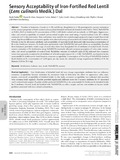| dc.contributor.author | Podder, Rajib | |
| dc.contributor.author | Khan, Shaan M. | |
| dc.contributor.author | Tar’an, Bunyamin | |
| dc.contributor.author | Tyler, Robert T. | |
| dc.contributor.author | Henry, Carol J. | |
| dc.contributor.author | Jalal, Chowdhury | |
| dc.contributor.author | Shand, Phyllis J. | |
| dc.contributor.author | Vandenberg, Albert | |
| dc.date.accessioned | 2022-03-03T05:13:32Z | |
| dc.date.available | 2022-03-03T05:13:32Z | |
| dc.date.copyright | 2018 | |
| dc.date.issued | 2018-02-22 | |
| dc.identifier.citation | Podder, R., Khan, S.M., Tar'an, B., Tyler, R.T., Henry, C.J., Jalal, C., Shand, P.J. and Vandenberg, A. (2018), Sensory Acceptability of Iron-Fortified Red Lentil (Lens culinaris Medik.) Dal. Journal of Food Science, 83: 804-813. https://doi.org/10.1111/1750-3841.14066 | en_US |
| dc.identifier.uri | http://hdl.handle.net/10361/16384 | |
| dc.description | This article was published in the Journal of Food Science [© 2018 Institute of Food Technologists® ] and the definite version is available at : https://doi.org/10.1111/1750-3841.14066 The Journal's website is at: https://ift.onlinelibrary.wiley.com/doi/full/10.1111/1750-3841.14066 | en_US |
| dc.description.abstract | Panelists in Saskatoon, Canada (n=45) and Dhaka, Bangladesh (n=98) participated in sensory evaluationsof the sensory properties of both cooked and uncooked dehulled red lentil dal fortified with FeSO4·7H2O, NaFeEDTAor FeSO4·H2O at fortificant Fe concentrations of 800, 1,600 (both cooked and uncooked), or 2,800 ppm. Appearance,odor, and overall acceptability of cooked and uncooked samples were rated using a 9-point hedonic scale (1=dislikeextremely to 9=like extremely). Taste and texture were rated for the cooked samples prepared as typical south Asian lentilmeals. Significant differences in sensory quality were observed among all uncooked and cooked samples at both locations.Overall, scores for all sensory attributes and acceptability of uncooked lentil decreased with increasing concentration ofFe in the fortificant; however, Fe fortification (particularly with NaFeEDTA) had small effects on acceptability. Panelistsfrom Saskatoon provided a wider range of scores than those from Bangladesh for all attributes of cooked lentil. Overall,sensory evaluation of Fe fortification using NaFeEDTA minimally affected consumer perception of color, taste, texture,odor, and overall acceptability of cooked lentil. Reliability estimates (Cronbach’s alpha [CA]) indicated that consumerscores were generally consistent for all attributes of all lentil samples (mean CA>0.80). NaFeEDTA was found to be themost suitable Fe fortificant for lentil based on consumer acceptability. Consumption of 45 to 50 g of NaFeEDTA-fortifiedlentil (fortificant Fe concentration of 1,600 ppm) per day meets the estimated average requirements (EARs) of Fe forhumans (10.8 to 29.4 mg) | en_US |
| dc.language.iso | en_US | en_US |
| dc.publisher | Institute of Food Technologists (IFT) | en_US |
| dc.relation.uri | https://ift.onlinelibrary.wiley.com/doi/full/10.1111/1750-3841.14066 | |
| dc.subject | Fortification | en_US |
| dc.subject | Hedonic | en_US |
| dc.subject | Iron | en_US |
| dc.subject | Lentil | en_US |
| dc.subject | NaFeEDTA | en_US |
| dc.subject | Sensory | en_US |
| dc.title | Sensory acceptability of iron-fortified red lentil (Lens culinaris Medik.) Dal | en_US |
| dc.type | Journal Article | en_US |
| dc.description.version | Published | |
| dc.contributor.department | Brac James P. Grant School of Public Health | |
| dc.identifier.doi | https://doi.org/10.1111/1750-3841.14066 | |
| dc.relation.journal | The Journal of Food Science | |

